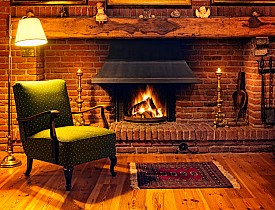Aged to Perfection: Techniques for Antiquing Wood
 "Aged", "antiqued", "distressed" ... these are some of the adjectives that people use to describe how they envision the finish on their cabinets or furniture. From an artist's perspective, these are very vague terms. They cover a full spectrum of different techniques that all fall under the generalized category of "antiquing". There is a big difference between a little bit of color in the corners and truly "aged".
"Aged", "antiqued", "distressed" ... these are some of the adjectives that people use to describe how they envision the finish on their cabinets or furniture. From an artist's perspective, these are very vague terms. They cover a full spectrum of different techniques that all fall under the generalized category of "antiquing". There is a big difference between a little bit of color in the corners and truly "aged".
The charm of "aging" is that it represents what happens naturally over time as previous finish treatments are exposed to different elements. For example, there is more wear around edges and handles. Dust settles low. Sun shines inconsistently on vertical surfaces and causes layers of paint to fade and split. Horizontal surfaces and corners take the brunt of the burden for scuffs and scrapes. When done correctly, these pieces actually tell a story. It is helpful to create a mental image about how the object was used or where it was as each layer and technique is applied.
It is important to define exactly how "old" you want it to look. Begin by gathering photos that will show examples of your expectations. You may already have a small piece, like a picture frame, that will provide inspiration. One client even took me outside to view her weathered shutters!
There are many processes that can be used to imitate chapters of an authentic aging story. These artistic techniques can be incorporated into your painting project to give it the true character that is needed to make it appear authentic and believable. Here is a list of these processes.
- "Antique glazing" is the appearance that dust has settled on surfaces and in crevices. Over many efforts to wipe them down, topcoats are scrubbed and become weak. There will be remnants of dark streaks and smears.
- "Rub-throughs" are areas where the layers of paint have been chipped or worn off. These are usually on random areas such as raised surfaces, edges or around handles and drawer pulls (but not on every edge).
- "Crackling" is a simulation of what happens to layers of paint when the wood underneath expands and contracts over time. Temperature, humidity and light exposure will cause any or all of the individual layers of paint to split and shrink, exposing the surface below. Where and how much it happens is inconsistent. For the deep layers of paint, a "lineal crackle" technique most accurately represents these separations or cracks along the grain of the wood. Think about an old wooden fence as the paint chips and flakes in lines.
- "Distressing" shows that furniture or cabinetry has been well used over the years. These are scratches, divots, dents and gouges that are inevitable during the lifetime of a piece. The surface must first be soft enough to allow the tools to penetrate the existing finish. Do not be surprised when the artist brings hammers, screws, chisels or even a bicycle chain to create this effect. Again, this is not an overall process. It is merely representative of occasional "mishaps" that have occurred over the years.
- "Raised graining" is simulated with small amounts of texture to look like the natural expansion of layers within a piece of wood. This gives the appearance of old barn wood or even driftwood.
- "Fly specs or spatters" are exactly that. It is the creation of remnants left by flies. They are usually more concentrated in corners and the highest points of the furnishings rather than an all over effect. This is quite popular when the piece is going into a farmhouse style home.
- "Charring or smoke damage" is the simulation that this piece has survived a fire. It can be as simple as some dark areas where soot has collected. For a more dramatic effect, raised black patches can be applied to appear as if the paint bubbled where it was exposed to extreme heat.
- "Water spots" are the illusion of places that have been exposed to excessive amounts of moisture. They are subtle circles that make it look as if the piece was left out in the rain or sprayed with water.
- "Mold" will often coincide with water spots. Unlike a white or lime wash, it is slightly raised light areas that occur randomly on places near or around water spots.
Perfect aging is never perfect! It occurs as a result of unique experiences that add to the character of each individual piece. To achieve the charm of authenticity, multiple techniques should be used on a single project to represent the true personality of the story. Allow your processes to have random and subtle inconsistencies. The result will offer the intrigue of a hand-and-time-crafted finish rather than a factory-produced finish.
Kass Wilson is a Networx - https://www.networx.com - writer. Get home & garden ideas like this - https://www.networx.com/article/aged-to-perfection-techniques-for-antiq - on Networx.
Looking for a Pro? Call us (866) 441-6648

Painting Average Costs
Painters Experiences

The Stamped Concrete Patio I’ve Been Waiting For

No Budget For A New Deck This Year? Try This Affordable Option



